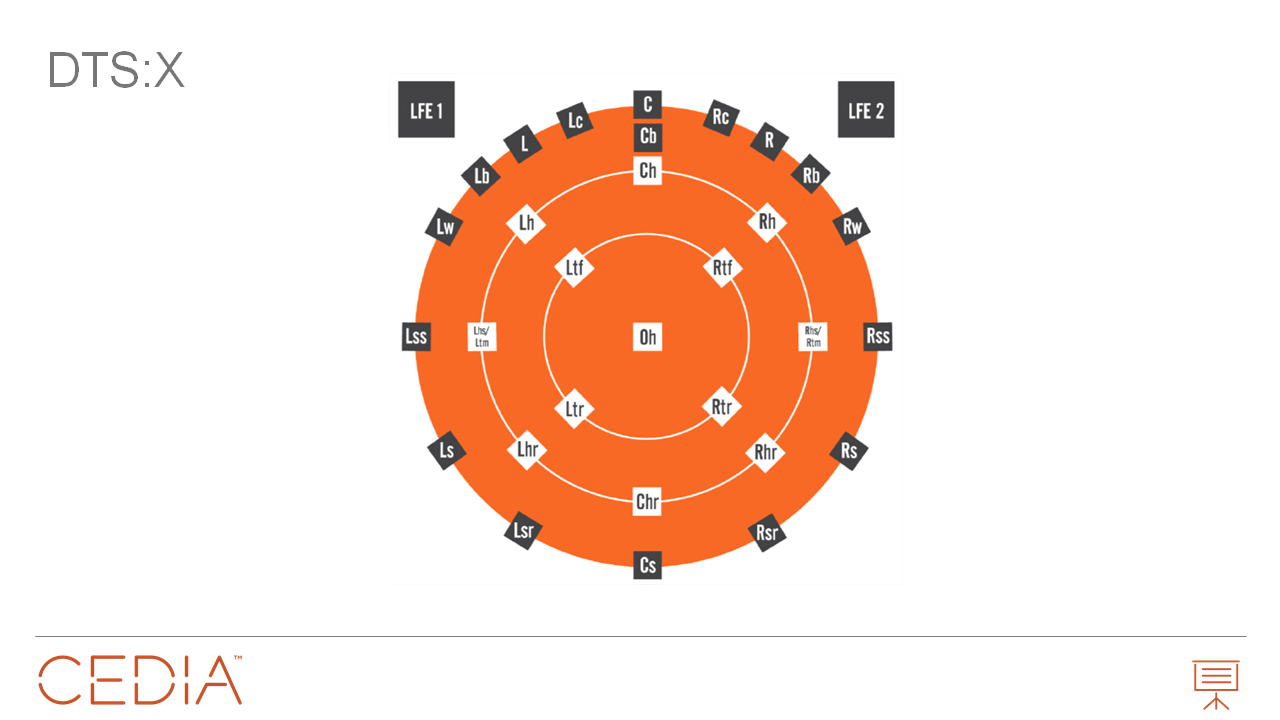Immersive sound
« Sound is half of the film experience » Georges Lucas
Immersive—or 3D sound —is a new advance in sound reproduction, taking us from multichannel approach (5.1 or 7.1) which enables sound to be perceived from the side and rear, to an incredibly deep and immersive sound experience that puts spectators right in the center of the action.
Far more precise and enveloping, 3D sound uses sound objects that plunge the spectator into a three-dimensional environment putting the show everywhere in the room, as the sound objects surprise viewers by moving around in three dimensions.
To be fully compatible with the following formats and ensure adequate sound reproduction, the system must be configured in 7.4.4 at the very minimum, and ideally in 9.4.10 or better, such as 11.4.10 if the room permits:
The two first standards are based on the concept of sound objects, but Auro 3D is a layered multichannel management system offering a highly realistic sound experience. Because different standards are involved, a sufficient number of speakers must be positioned properly and at the right angles.
| AURO 3D : | Dolby Atmos : | DTS X : |
 |
 |
 |
We would be delighted to advise and assist you in upgrading your private cinema or design or in installing an entirely new system that will plunge you headfirst into an ultimate sound experience.
Image quality
Image quality has never been better with the emergence of blu-ray and the subsequent rise in storage capacity. Three modifications required to implement this new technology are particularly beneficial to home cinema systems:
New Ultra High Definition (UHD) format: The format used in mass market media 3840 x 2160 to replace 1920 x 1080. (Note: professional cinema format is 4K 4096 X 2160);
Expanded color space: The current color space (Rec 709) is narrow (37%) relative to the spectrum visible to the naked eye. The 1936 ILC (International Lighting Commission) chromaticity diagram shown below illustrates the spectrum visible to the naked eye, as well as the various color spaces:
- Current color space: REC 709; 34% of the spectrum visible to the naked eye (current blu-ray)
- DCI/P3 used by professional cinema; 46% of the spectrum visible to the naked eye (blu-ray 4k)
- Rec 2020 can reproduce a more “natural” color space: 67% (future blu-ray 4k) but is under discussion because few technologies are currently available to implement it

New High Dynamic Range (HDR) lighting intensity standards reproduce the entire lighting spectrum evoked below with all possible intensity variations, from dimmest (absolutely dark) to brightest (the sun) to achieve absolute color saturation. This is the “third dimension” in imagery.
As with sound, Audire possesses leading-edge calibration instruments to apply these standards to your home cinema system.
With HDR, colors are much more vivid and perfectly contrasted. Ultra HR premium is obtained by combining this image quality with 3D sound.
Acoustical treatment
Acoustical treatment is one of the secrets to exceptional sound. State-of-the-art sound diffuser panels, which send sound waves in multiple directions, and acoustic panels, which transform sound pressure into heat, are used to control primary sound reflection, reverberation time, etc.
Every room is unique, so your acoustical treatment must be perfectly tailored to perform as it should. Your system is not and should not be a pale copy of an existing installation. Customization is a must, because packaged solutions simply can’t deliver the level of perfection you seek.
Acoustical treatment must also be sized properly, particularly when it comes to thickness. The immutable laws of physics dictate that panels must be at least 10 to 30 cm thick. Remember that at a frequency of 300 Hertz, the human voice is a quarter wavelength longer than 28 cm!
With high-quality modules, you can get excellent results. On a practical level, we are careful to obtain the best possible reverberation time values (RT60), while all other approaches tend to produce inferior results.
Examples of the modules we use (dimensions 60x60 cm):

Design of Philippe’s home cinema in Brussels:
Include Philippe PDF: Include acoustical treatment (PDF)
Software simulation of subwoofer response: Simulated subwoofer response (Excel)
Please note that the examples below are not home cinemas, but post-production studios used to make films. Film directors and filmmaking teams evaluate sound and audio performance in this environment, which must hence be technically perfect. Below are a few examples of post-production studios:


A highly-consistent response curve can subsequently be obtained. The following image illustrates the response curve obtained at Philippe’s home cinema in Brussels prior to equalization:

Then come the calibration measurements and long hours of tuning. Audire provides a complete and detailed report on all measurements and calibrations of your screens and projectors.

Left: Private home cinema, M. Samy Maroun, Beirut; Right: Calibration of a multimedia room in Larchmont, NY.
One computer is used to take measurements, another to manage the processors and verify performance in real time. Each measurement is completed by a plethora of sound samples, according to international HAA protocols.
The home cinema systems installed by Audire sound better than most because we consider your project in its own right, and measure every element of performance from end to end, from sound architecture to turnkey system commissioning. Your project is unique, and deserves this level of professionalism.
Our professionalism is also a matter of ethics. How could we do otherwise, for example, when Richard Berry, an Audire customer, after directing the film L’immortel, attends the sound mixing session from his Audire installation, while a symphony orchestra plays in the Abbey Road studio with the composer linked by satellite from Los Angeles? Indeed, how could we dare install a system that fails to respect the hard work and immense resources deployed for the soundtrack of a full-length feature film?
We believe in doing everything in our power to make you feel the full emotional impact of the films you watch, for your enjoyment and out of respect for those who worked so hard to make them.




